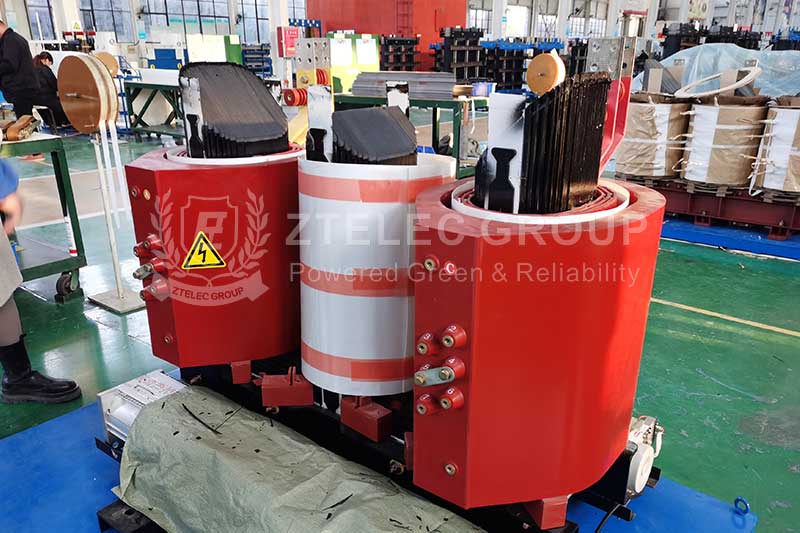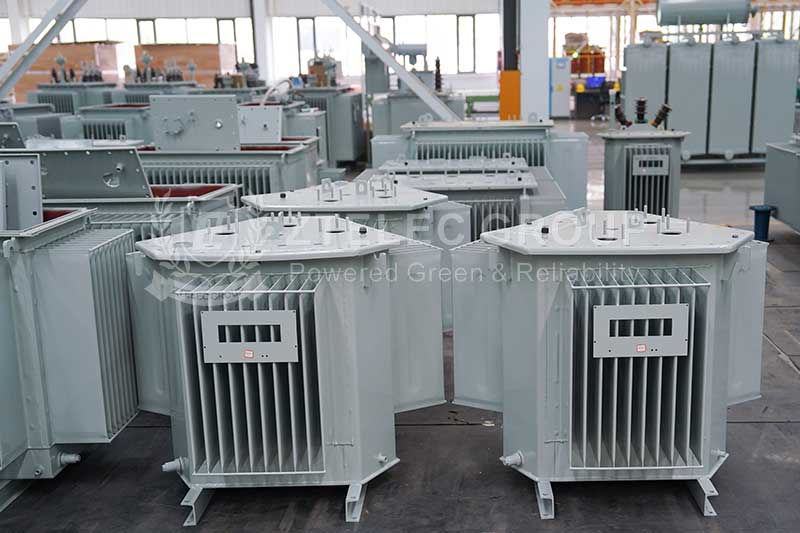In-depth Understanding of Dry-type Transformers and Oil-immersed Transformers
Transformers play a crucial role in power systems. They are responsible for stepping up or stepping down voltage levels to achieve efficient power transmission and distribution. Among them, dry-type transformers and oil-immersed transformers are two common types, each having its unique features and applications. This article will explore these two types of transformers in detail to help everyone better understand their working principles, performance characteristics, and applications in different fields.
I. What is a Dry-type Transformer and its Working Principle?
A dry-type transformer is a transformer that uses air or other gases as a cooling medium. It consists mainly of a core, windings, and insulating materials. Its working principle is similar to that of oil-immersed transformers, both converting alternating current energy from one voltage level to another through electromagnetic induction.
When the alternating current flows through the primary winding of the transformer, it generates an alternating magnetic field within the core. This alternating magnetic field induces an electromotive force in the secondary winding, thus achieving voltage transformation. Since the cooling medium of dry-type transformers is air or other gases, their heat dissipation primarily occurs through natural convection and radiation.

What Are the Product Features of Dry-type Transformers?
1. Safe and Environmentally Friendly
Dry-type transformers do not use insulating oil, so there is no risk of fire or explosion. Additionally, they do not pollute the environment, meeting modern society's environmental protection requirements.
2. Convenient Installation
Dry-type transformers are compact and lightweight, requiring no auxiliary facilities like oil pits during installation, making them quite convenient. Furthermore, dry-type transformers can be installed indoors or outdoors, offering strong adaptability.
3. Low Maintenance Costs
As dry-type transformers do not require insulating oil, regular oil quality testing and replacement are not needed, leading to low maintenance costs. Moreover, dry-type transformers have a long lifespan and high reliability, reducing the need for repairs and replacements.
4. Strong Overload Capacity
Dry-type transformers have a strong overload capacity, allowing them to withstand large overload currents for short periods without damage. This gives them a significant advantage in specific applications, such as emergency power supplies.
Application Areas for Dry-type Transformers
1. High-rise Buildings
Due to their safety, environmental friendliness, and convenient installation, dry-type transformers are highly suitable for use in high-rise buildings. In such buildings, space is limited, and there are high demands for the safety and reliability of equipment; dry-type transformers meet these requirements perfectly.
2. Commercial Centers
Commercial centers have high power consumption and demand great stability and reliability from their electrical equipment. Dry-type transformers can ensure stable power supply for commercial centers, and their environmentally friendly nature aligns with the center's environmental requirements.
3. Hospitals, Schools, and Equivalent Locations
Hospitals and schools have very high demands for electrical reliability, and power outages can have severe consequences. Dry-type transformers, with their high reliability and stability, can offer a dependable power supply for these establishments.
4. Rail Transportation
The rail transportation system requires extremely high levels of safety and reliability from its equipment. Dry-type transformers can adapt to the unique environments of rail transportation systems, providing stable power supply.
II. What is an Oil-immersed Transformer and its Working Principle?
An oil-immersed transformer is a transformer that uses insulating oil as both a cooling medium and insulating material. It mainly consists of a core, windings, oil tank, and insulating sleeves. Its working principle is the same as that of dry-type transformers, converting alternating current energy from one voltage level to another through electromagnetic induction.
In an oil-immersed transformer, the insulating oil serves not only as a cooling agent but also as an insulator. When the transformer is operating, heat is generated in the windings and core, which is transmitted through the insulating oil to the oil tank wall, and then dissipated into the surrounding environment through natural convection and radiation.

What Are the Product Features of Oil-immersed Transformers?
1. Good Heat Dissipation Performance
Oil-immersed transformers utilize insulating oil as a cooling medium, resulting in excellent heat dissipation performance, allowing them to handle larger loads. Additionally, the insulating oil also provides insulation and arc-extinguishing capabilities, enhancing the safety and reliability of the transformers.
2. Large Capacity
Oil-immersed transformers can be manufactured with very large capacities, making them suitable for high-power electricity transmission and distribution. This is due to the effective heat dissipation and insulation provided by the insulating oil, which allows the windings and core to handle larger currents and voltages.
3. Relatively Low Cost
Compared to dry-type transformers, oil-immersed transformers are relatively less expensive. This is because the manufacturing process for oil-immersed transformers is generally simpler and more cost-effective.
4. Maintenance requirements for oil-immersed transformers are high:
Due to the use of insulating oil in oil-immersed transformers, regular maintenance such as oil quality testing and replacement is necessary. Additionally, oil-immersed transformers require the installation of auxiliary facilities like oil pits, which increases the difficulty and cost of maintenance.
Applications of oil-immersed transformers
1. Power system
Oil-immersed transformers are one of the most commonly used types of transformers in power systems. They can be used in power plants, substations, and other locations to provide stable voltage conversion and power transmission for the power system.
2. Industrial sector
In the industrial sector, oil-immersed transformers are widely used for the power supply of various large machinery and equipment. For example, large industrial enterprises such as steel mills, chemical plants, and cement factories all require oil-immersed transformers to meet their high-power electricity demands.
3. Rural power grid
The load in rural power grids is relatively small, but there are high requirements for the reliability and stability of the transformers. Oil-immersed transformers are relatively low in price and have a large capacity, making them suitable for electricity transmission and distribution in rural power grids.
III. Comparison of Dry-Type Transformers and Oil-Immersed Transformers
1. Cooling Methods of Dry-Type and Oil-Immersed Transformers
Dry-type transformers use air or other gases as a cooling medium, primarily relying on natural convection and radiation for heat dissipation. Oil-immersed transformers utilize insulating oil as a cooling medium, offering excellent heat dissipation capabilities and the ability to handle larger loads.
2. Safety of Dry-Type and Oil-Immersed Transformers
Dry-type transformers do not use insulating oil, thus eliminating the risk of fire and explosion, resulting in higher safety. Conversely, oil-immersed transformers use insulating oil, which can pose fire and explosion risks in case of leaks or malfunctions, making them relatively less safe.
3. Capacity of Dry-Type and Oil-Immersed Transformers
The capacity of oil-immersed transformers can be made quite large, making them suitable for high-power electricity transmission and distribution. Dry-type transformers have a relatively smaller capacity, making them more suitable for medium and low-power electrical applications.
4. Price of Dry-Type and Oil-Immersed Transformers
Oil-immersed transformers are generally less expensive due to simpler manufacturing processes. Dry-type transformers are comparatively more expensive; however, their advantages in safety, environmental friendliness, and ease of installation make them favorable for certain specific applications.
5. Maintenance Costs of Dry-Type and Oil-Immersed Transformers
Dry-type transformers do not require regular oil quality testing and replacement, resulting in lower maintenance costs. In contrast, oil-immersed transformers require periodic oil quality testing and replacement, leading to relatively higher maintenance costs.
Both dry-type and oil-immersed transformers have their own characteristics and application scenarios. When choosing a transformer, it is essential to consider actual needs comprehensively. If safety and environmental concerns are high, or installation space is limited, a dry-type transformer may be preferred. If a large capacity transformer is needed, or price sensitivity is a factor, then an oil-immersed transformer may be the better choice.
- more+releated article
- 2025-12-13How to Select and Use Phenolic Cloth-base Lami
- 2025-12-13How Much Does Bakelite Sheet Cost? 2025 Price
- 2025-12-13Why are most 3240 epoxy boards yellow?
- 2025-12-13What are the Main Applications of FR4 Epoxy Bo
- 2025-12-13Why Does the Price of Insulating Paperboard Va
- 2025-12-13Heat-Resistant DDP Insulation Paper
- 2025-12-13Comparison of Heat-Resistant DDP Insulating Pa
- 2025-12-13G10 and FR4 Epoxy Boards: Commonly Used for Ge
- 2025-12-13The Price of Heat-Resistant DDP Insulation Pap
- 2025-12-13How to Choose Epoxy Laminate Materials for Gen





